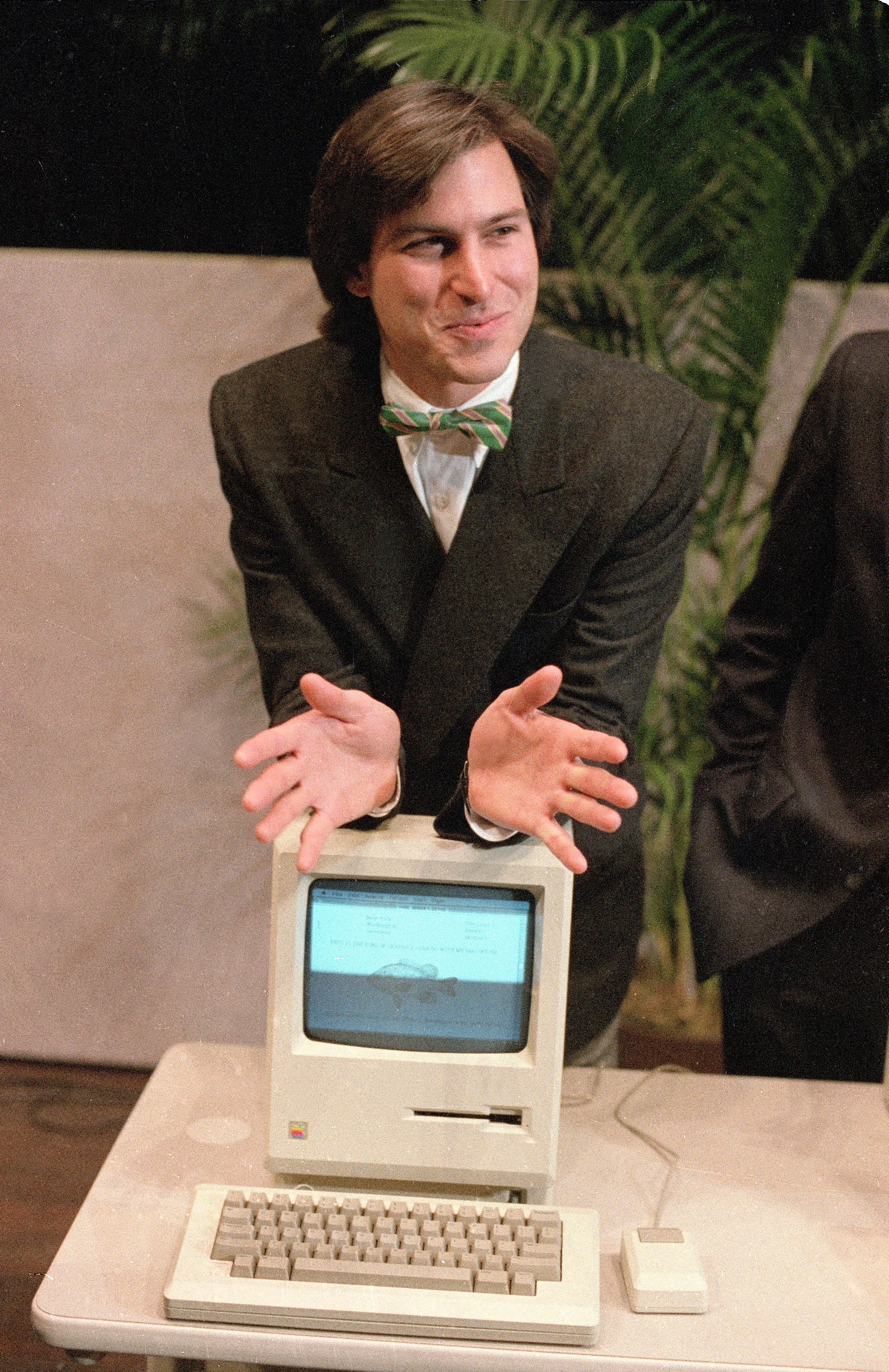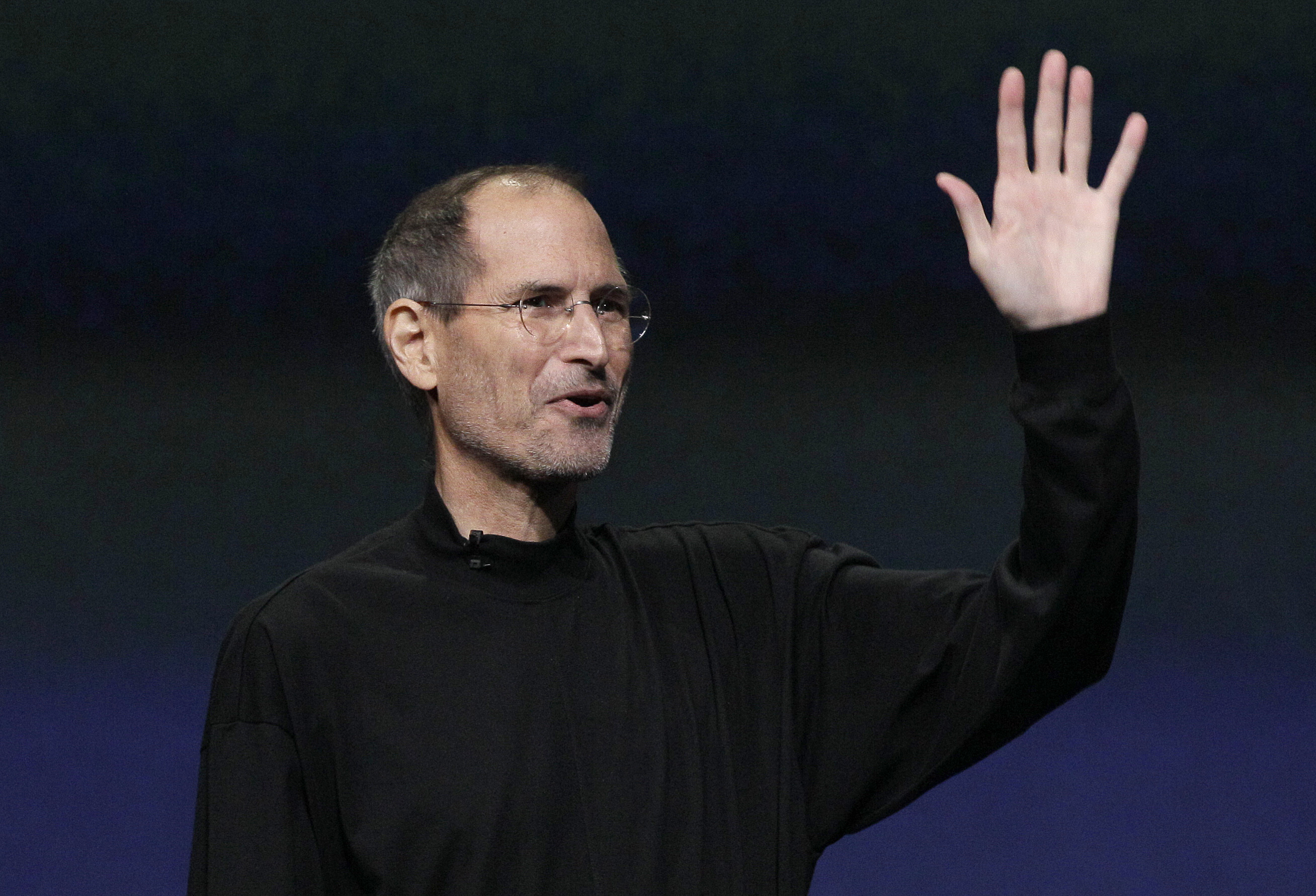Apple says Steve Jobs resigning as CEO
Wednesday, August 24, 2011
 In this Jan. 24, 1984 file photo, Steven Jobs, chairman of the board of Apple Computer, leans on the new Macintosh personal computer following a shareholder's meeting in Cupertino, Ca. Apple Inc. on Wednesday, Aug. 24, 2011 said Jobs is resigning as CEO, effective immediately. He will be replaced by Tim Cook, who was the company's chief operating officer. It said Jobs has been elected as Apple's chairman. (AP Photo/Paul Sakuma, File)
In this Jan. 24, 1984 file photo, Steven Jobs, chairman of the board of Apple Computer, leans on the new Macintosh personal computer following a shareholder's meeting in Cupertino, Ca. Apple Inc. on Wednesday, Aug. 24, 2011 said Jobs is resigning as CEO, effective immediately. He will be replaced by Tim Cook, who was the company's chief operating officer. It said Jobs has been elected as Apple's chairman. (AP Photo/Paul Sakuma, File)SAN FRANCISCO - Steve Jobs, the mind behind the iPhone, iPad and other devices that turned Apple Inc. into one of the world's most powerful companies, resigned as the company's CEO on Wednesday, saying he can no longer handle the job.
The move appears to be the result of an unspecified medical condition for which he took an indefinite leave from his post in January. Apple's chief operating officer, Tim Cook, has been named CEO.
In a letter addressed to Apple's board and the "Apple community," Jobs said he "always said if there ever came a day when I could no longer meet my duties and expectations as Apple's CEO, I would be the first to let you know. Unfortunately, that day has come."
Jobs' health has long been a concern for Apple investors who see him as an industry oracle who seems to know what consumers want long before they do. After his announcement, Apple stock quickly fell 5.4 percent in after-hours trading.
The company said Jobs gave the board his resignation Wednesday and suggested Cook be named the company's new leader. Apple said Jobs was elected board chairman and Cook is becoming a member of its board.
Jobs' hits seemed to grow bigger as the years went on: After the colorful iMac computer and the now-ubiquitous iPod, the iPhone redefined the category of smart phones and the iPad all but created the market for tablet computers.
His own aura seemed part of the attraction. On stage at trade shows and company events in his uniform of jeans, sneakers and black mock-turtlenecks, he'd entrance audiences with new devices, new colors, new software features, building up to a gran finale he'd predictably preface by saying, "One more thing."
Jobs, 56, shepherded Apple from a two-man startup to Silicon Valley darling when the Apple II, the first computer for regular people to really catch on, sent IBM Corp. and others scrambling to get their own PCs to market.
After Apple suffered slump in the mid-1980s, he was forced out of the company. He was CEO at Next, another computer company, and Pixar, the computer-animation company that produced "Toy Story" on his watch, during the 10 years before he returned.
The January leave was Jobs' third medical leave over several years. He had previously survived pancreatic cancer and received a liver transplant.
10 products that defined Steve Jobs' career
NEW YORK - Steve Jobs had no formal schooling in engineering, yet he's listed as the inventor or co-inventor on more than 200 U.S. patents. These are some of the significant products that were created under his direction:
1. Apple I (1976) - Apple's first product was a computer for hobbyists and engineers, made in small numbers. Steve Wozniak designed it, while Jobs orchestrated the funding and handled the marketing.
2. Apple II (1977) - One of the first successful personal computers, the Apple II was designed as a mass-market product rather than something for engineers or enthusiasts. It was still largely Wozniak's design. Several upgrades for the model followed, and the product line continued until 1993.
3. Lisa (1983) - Jobs' visit to Xerox Corp.'s research center in Palo Alto inspired him to start work on the first commercial computer with a graphical user interface, with icons, windows and a cursor controlled by a mouse. It was the foundation for today's computer interfaces, but the Lisa was too expensive to be a commercial success.
4. Macintosh (1984) - Like the Lisa, the Macintosh had a graphical user interface. It was also cheaper and faster and had the backing of a large advertising campaign behind it. People soon realized how useful the graphical interface was for design. That led "desktop publishing," accomplished with a Mac coupled to a laser printer, to soon become a sales driver.
5. NeXT computer (1989) - After being forced out of Apple, Jobs started a company that built a powerful workstation computer. The company was never able to sell large numbers, but the computer was influential: The world's first Web browser was created on one. Its software also lives on as the basis for today's Macintosh and iPhone operating system.
6. iMac (1998) - When Jobs returned to Apple in 1996, the company was foundering, with an ever shrinking share of the PC market. The radical iMac was the first step in reversing the slide. It was strikingly designed as a bubble of blue plastic that enclosed both the monitor and the computer. Easy to set up, it captured the imagination just as people across the world were having their eyes opened to the benefits of the Internet and considering getting their first home computer.
7. iPod (2001) - It wasn't the first digital music player with a hard drive, but it was the first successful one. Apple's expansion into portable electronics has had vast ramifications. The iPod's success prepared the way for the iTunes music store and the iPhone.
8. iTunes store (2003) - Before the iTunes store, buying digital music was a hassle, making piracy the more popular option. The store simplified the process and brought together tracks from all the major labels. The store became the largest music retailer in the U.S. in 2008.
9. iPhone (2007) - The iPhone did for the phone experience what the Macintosh did for personal computing - it made the power of a smartphone easy to harness. Apple is now the world's most profitable maker of phones, and the influence of the iPhone is evident in all smartphones.
10. iPad (2010) - Dozens of companies, including Apple, had created tablet computers before the iPad, but none caught on. The iPad finally cracked the code, creating a whole new category of computer practically by itself.

